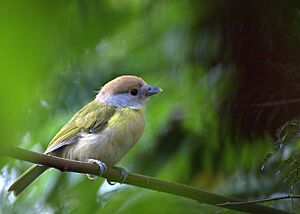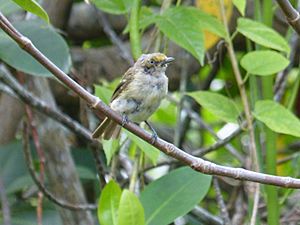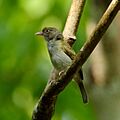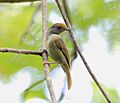Vireo facts for kids
Quick facts for kids Vireos |
|
|---|---|
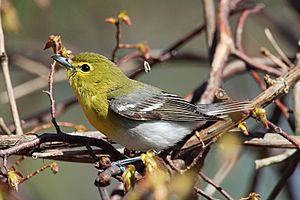 |
|
| Yellow-throated vireo (Vireo flavifrons) | |
| Scientific classification |
|
| Kingdom: | Animalia |
| Phylum: | Chordata |
| Class: | Aves |
| Order: | Passeriformes |
| Superfamily: | Corvoidea |
| Family: | Vireonidae Swainson, 1837 |
| Genera | |
|
|
Vireos are a family of small to medium-sized birds called Vireonidae. These birds live in many parts of the world. You can find them in the Americas, from Canada all the way to Argentina. They also live in places like Bermuda, the West Indies, and even parts of Southeast Asia.
There are 62 different kinds of vireos, and scientists group them into eight main types, called genera. The word "Vireo" comes from Latin. It means a green bird that travels, possibly like a female golden oriole or a European greenfinch.
Vireos usually have feathers that are not very bright. They are often greenish. The smaller vireos look a bit like wood warblers, but they have stronger, thicker beaks. These birds come in different sizes. Some, like the Chocó vireo, are tiny, about 10 centimeters long and weighing only 8 grams. Others, like the peppershrikes, can be up to 17 centimeters long and weigh 40 grams.
Contents
Where Vireos Live: Distribution and Habitat
Most vireo species make their homes in Central America and the northern parts of South America. However, you can find thirteen types of "true" vireos much farther north. These include species living in the United States, Bermuda, and Canada. Most of these northern vireos are migratory, meaning they travel long distances between their summer and winter homes. Only one, Hutton's vireo, usually stays in the same place all year.
Vireos generally do not fly long distances, except when they are migrating. They love living in forests. Different kinds of vireos prefer different parts of the forest. Some like the very tops of the trees, called the canopy. Others prefer the bushes and plants closer to the ground, known as the undergrowth. Some even live in mangrove swamps, which are special forests found along coastlines.
Sometimes, a few vireos from the Vireo group have been seen far from their usual homes. They have appeared on the eastern side of the Atlantic Ocean, in places like Europe. These birds are called "vagrants" because they wandered off their normal path.
Vireo Life: Behavior and Habits
Vireos that stay in one place all year are called "resident" species. They often live in pairs or small family groups. These groups protect their own special area, called a territory, throughout the year. Hutton's vireo is a bit different; it sometimes joins groups of other bird species to find food.
Most vireos that migrate also protect their own territories during the winter. They keep other vireos of the same kind (called conspecifics) out of their space. However, some vireos, like the red-eyed vireo and the yellow-green vireo, are exceptions. They spend their winters traveling in small groups, rather than defending a single territory.
Vireo Songs: What Do They Sound Like?
Male vireos are known for singing a lot. Their songs are usually quite simple. Some species that live near the Caribbean coast and islands have songs that can sound a bit repetitive. But other vireos, like the Chocó vireo and the peppershrikes, have much more complex and lovely songs that are very pleasant to hear.
Raising Young: Vireo Reproduction
Scientists still don't know much about the nests of many vireo species that live in tropical areas. But for the nests we do know about, all vireos build a special cup-shaped nest. These nests hang carefully from tree branches.
The female vireo usually does most of the incubation, which means sitting on the eggs to keep them warm until they hatch. The male vireo sometimes helps by taking turns on the nest. However, in the group of birds that includes the red-eyed vireo, the female often does all the incubation herself.
What Vireos Eat: Their Diet
All vireos enjoy eating some fruit, but their main diet is made up of insects and other small creatures like spiders, which are called arthropods. They find their food by picking it off leaves and branches.
Some vireos, known as "true vireos," also catch insects while flying. This is called "flycatching." The gray vireo is a bit different, as it gets about 5 percent of its food from the ground.
Vireo Family Tree: How They Are Related
The Vireonidae family, which includes all vireos, is part of a larger group of birds. They are related to birds like crows (Corvidae) and shrikes (Laniidae). Scientists group them together in a "superfamily" called Corvoidea. Today, the vireo family has eight main groups, or genera.
For a long time, scientists thought the vireo family only included four groups from the Americas: the true vireos (Vireo), the greenlets (Hylophilus), the shrike-vireos (Vireolanius), and the peppershrikes (Cyclarhis).
However, as scientists learned more, they used special studies to look at the birds' DNA. These studies showed that the greenlet group (Hylophilus) was actually made up of different kinds of birds that weren't as closely related as once thought. Because of this, the greenlets were split into three new groups: the "scrub" greenlets (still in Hylophilus), the "canopy" greenlets (now in a group called Pachysylvia), and the tawny-crowned greenlet (in a new group called Tunchiornis). This shows how our understanding of bird families can change as new discoveries are made!
Interestingly, these studies also found that two groups of birds from Asia, called babblers (Pteruthius and Erpornis), might also be part of the vireo family. People had noticed that these Asian birds acted a bit like vireos, but it was a surprise to think they were related because they live so far away. Some bird experts now include Pteruthius and Erpornis in the Vireonidae family, while others prefer to keep them in their own separate families.
Images for kids
See also
 In Spanish: Vireónidos para niños
In Spanish: Vireónidos para niños


